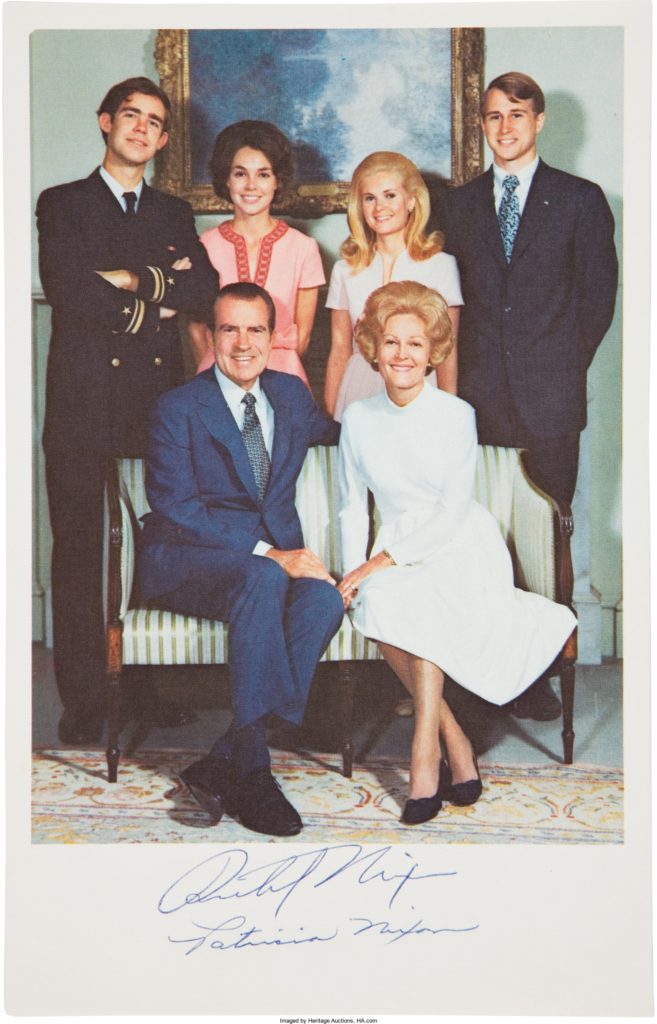
By Jim O’Neal
By most accounts, Patricia “Tricia” Nixon was the most beautiful of all White House brides. She was featured alone as the cover story on Life magazine not once but twice. By January 1971, the public was fascinated by her romance with Edward Finch Cox, a young Harvard Law student who had once worked with consumer activist Ralph Nader and written for the liberal New Republic.
Tricia and Ed came from opposite social and political poles. The young Mr. Cox could trace his lineage to a signer of the Declaration of Independence. His parents both had social pedigrees and spent their summers at the Long Island estate that had been in the family for six generations.
Richard Nixon was already a lightning rod for an increasingly adversarial media and traveled in much different circles. He had earlier defended himself from using a private fund for personal use by showcasing his modest lifestyle. He bragged that his wife could not boast of a mink coat, but owned a “respectable Republican cloth coat.”
Ed accompanied Tricia to the International Debutante Ball and discovered they had a lot in common. He was “aloof and private,” and she often avoided White House events and was called the “Howard Hughes of the WH” by her popular younger sister Julie. In fact, when Julie married Dwight David Eisenhower II in 1968, it was a small, private ceremony performed by minister and bestselling author Norman Vincent Peale. This alliance of the Nixon-Eisenhower dynasties was intriguing to the public, which naturally assumed Tricia was sure to follow in a more understated manner.
Surprisingly, the private Tricia chose a large White House wedding with a guest list of 400. First Lady Pat Nixon suggested a Rose Garden event and, after a long debate over the risk of rain, the date was set for June 12, 1971. Priscilla Kidder, the “doyenne of bridal outfitting,” designed the dress, and WH pastry chef Heinz Bender produced a 350-pound cantilevered cake that was dissed by some pompous food critics as a “lemony, sweetish non-entity” (tough crowd!).
There was intermittent rain in the morning, but the sun broke through right on schedule. Eighty-seven-year-old Alice Roosevelt was on hand, complaining that her seat was wet. Talking about the Nixon girls, Alice would offer one of her patented biting comments: “I like Julie better than Tricia. I’ve never been able to get on with Tricia. She seems rather pathetic, doesn’t she? I wonder what’s wrong with her?”
It has been pointed out that there were deep reasons and issues behind the famous quips of Alice Roosevelt. Sitting in her damp seat in the Rose Garden, her own glorious moment long forgotten and her famous father now covered over by multiple layers of important personalities and issues, Alice Roosevelt may have been lashing out at the only White House bride whose beauty transcended her own. Pure jealousy is a powerful emotion that takes a long time to dissipate.
The day after the wedding, Ed and Tricia were off to Camp David for their honeymoon. The New York Times broke some story about some “Pentagon Papers” from a little-known military analyst employed by the RAND Corporation. Few probably suspected that this would lead to an even more complex situation that would eventually jar the entire nation.
Fate seems to be indifferent to the emotions of mere mortals.
 Intelligent Collector blogger JIM O’NEAL is an avid collector and history buff. He is president and CEO of Frito-Lay International [retired] and earlier served as chairman and CEO of PepsiCo Restaurants International [KFC Pizza Hut and Taco Bell].
Intelligent Collector blogger JIM O’NEAL is an avid collector and history buff. He is president and CEO of Frito-Lay International [retired] and earlier served as chairman and CEO of PepsiCo Restaurants International [KFC Pizza Hut and Taco Bell].
